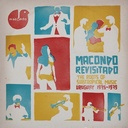TRACKLIST
A1 Sonido Cotopaxi– Melisa
A2 Grupo Electronico Keguay*– Alumbra Luna
A3 Las Estrellas de Macondo– Si Fueras Tu
A4 Tropicana 70– Plena Sensacional
A5 Conjunto Casino (3)– ¡ Que Golazo !
A6 Sonora Borinquen– El Disco Rayao
B1 Grupo Manati– La Noche
B2 Combo Camagüey– Parana
B3 Sonora Cienfuegos– Pies Mojados
B4 Grupo Latino– Resalsa
B5 Las Estrellas de Macondo– Maria Mercedes
C1 Sonora Borinquen– Recordanda A Mi Barrio
C2 Grupo Casino*– Plena Costera
C3 Anakaona– El Sequesito
C4 Sonora Cienfuegos– Solo Para Tontos
C5 Grupo Cubano– Quien No Vive En Mi Pais
D1 Conjunto Casino (3)– La Salsa Nostra
D2 Grupo Maracaibo– Juan
D3 Grupo Antillano (2)– Ya No Puedo Vivir Sin Ti
D4 Las Estrellas de Macondo– Tumbahiana
D5 Combo Camagüey– Costumbres
DESCRIPTION
An in-depth look at the 1970s catalogue of the Uruguayan label Macondo and the roots of Subtropical music: bomba, cumbia, guaracha, merengue, porro, plena… 21 tracks by essential names such as Sonora Borinquen, Conjunto Casino, Combo Camagüey, Sonora Cienfuegos, Grupo Maracaibo, Grupo Antillano… Compilation and notes by Nandy Cabrera aka Selectorchico.
Talking about Subtropical music could be seen as heresy but it’s necessary heresy. Necessary in order to start telling the story of this music born in the Caribbean but performed from the south, with its own characteristics and temperature. We’re talking about a peripheral phenomenon: the Uruguayan independent label Macondo and its discography linked to the 70s Montevideo dance music scene. Here we have a selection of some of the most prominent and best recordings created and released by Macondo between 1975 and 1979. Artists sought to emulate tropical music styles popular in Caribbean and Central American countries like Cuba (guaguancó, guaracha) Puerto Rico, Panama (bomba, plena, merengue) and Colombia (porro, vallenato and, of course, cumbia), but within this process of adaptation and hybridisation there are elements, procedures and codes that spawned a music that possesses a post-territorial identity and universe of its own. Arguably one of the most influential elements in this respect is the plena beat: this musical cell originally from Puerto Rico was embraced warmly by Uruguayan musicians, possibly due to its rhythmic-metric compatibility with the supreme Afro-Uruguayan beat, candombe. This grafting process is facilitated by the existence of the Afro-Uruguayan culture and population. We discover here yet another variation on the Afro-diaspora sound, part of the Black Atlantic psycho-geographical adventure. At the end of the 50s, big bands like Cortijo y su Combo or Sonora Matancera reached the Southern Cone for the first time. In parallel, the local pioneer Pedro Ferreira and his orchestra, the Cubanacan, worked to lay the foundations of the candombe songbook, as well as performing Afro-Cuban and Brazilian repertoires. Meanwhile the records of César Concepción, Moncho Leña, Mon Rivera and others were adopted and covered; re-appropriated by this new generation with complete naturalness. There was a strong cultural impact and as a result a new generation of groups emerged from the melting pot of all these different influences: the names and repertoires of the groups Combo Camagüey, Sonora Borinquen, Sonora Cienfuegos, Grupo Latino point straight back to their heritage while these acts embarked on their respective recording journeys with labels like Clave, Orfeo and Mallarini. Set up in the port area of Montevideo, Macondo Discos was founded by the Chilean entrepreneur Luis Onel and named after the town from García Márquez’s fictional universe. In its early days the label produced a catalogue comprising folk, tango, murga and rock. 1975 onwards, after the release of the LPs “Tropical caliente” by Cienfuegos and “Exclusivo!” by Borinquen, marks the “Golden Age of tropical music in our country” according to Carlos Goberna, founder of Sonora Borinquen. Macondo became a veritable tropical music factory in Uruguay, amassing together with Guacamayo (a sublabel dedicated to new artists) nearly 200 records in its ten years of existence. One of the most important figures from this era is the arranger, composer and trumpeter Mario Maldonado. He started his career in the mid-60s in Sonora Veracruz, a legendary outfit where he met vocalist Chico Ferry. Then both coincided again in the Conjunto Casino, led by the trumpeter Ernesto Negrín. Maldonado would then go on to join Grupo Cubano, Borinquen and direct the musical production of records by Antillano, Maracaibo and others. Half of the compositions on the album “Las estrellas de Macondo” (“The Stars Of Macondo”), created under his musical direction and arrangements, were written by him. He was one of the outstanding performers and musicians on the label, collaborating on an album where the search for a more sophisticated sound is clear, with more meticulous and orchestrated arrangements, presenting a more challenging repertoire in pursuit of a more contemporary and electric sound. The artists who took part in the project include Dardo Martínez on guitar and bass (Borinquen), Yeneca Natal on the piano (Maracaibo), and on tumbadoras Jorge Magariños (Magú) from Grupo Cubano, Walter Aguirre (Campeón) and Benjamín Arrascaeta, leader and founder of Conjunto Cienfuegos.


